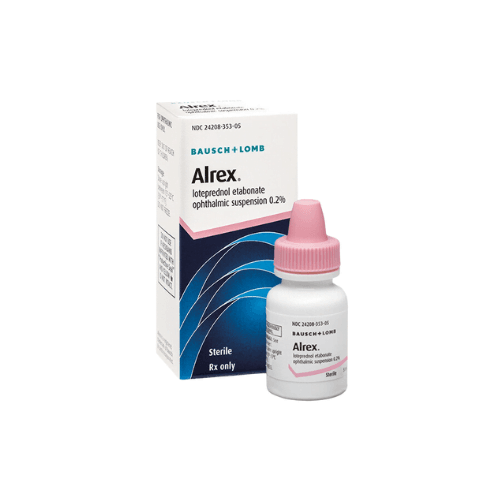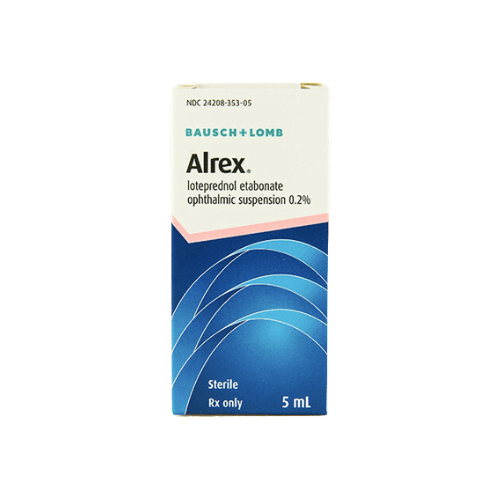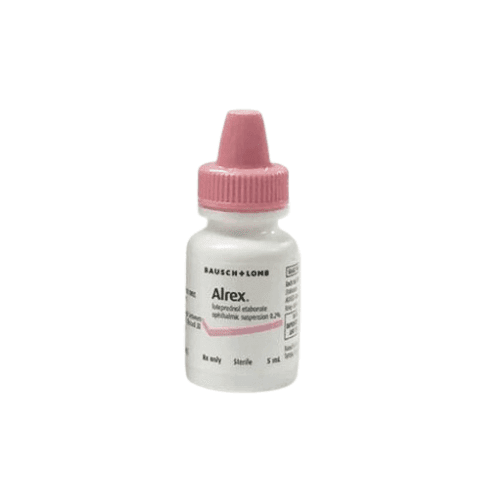Shipping with this method takes 3-5 days
Alrex® Ophthalmic Suspension for Allergic Conjunctivitis
$71.99
Secure Encrypted Payments
These prescription steroid eye drops help relieve itchy, red, allergic eyes. They reduce inflammation on the surface of the eye during seasonal flares. You can order with US shipping from Canada and compare options even without insurance.
What Alrex® Is and How It Works
YouDrugstore is a licensed Canadian pharmacy in Manitoba. Pharmacists review prescriptions before dispensing.
Alrex eye drops contain a topical corticosteroid used for the temporary relief of the signs and symptoms of seasonal allergic conjunctivitis. The active ingredient is loteprednol etabonate, a corticosteroid designed for ocular use. It works by suppressing inflammatory mediators in the conjunctiva, which can reduce redness, swelling, and itching. This medicine acts locally in the eye; your prescriber may recommend short courses during allergy season.
If you’re comparing treatments for itchy, watery eyes, explore our condition page for Allergic Conjunctivitis. For broader context on allergy triggers, see our article on Seasonal Allergies.
Who It’s For
This therapy is used for patients diagnosed with seasonal allergic conjunctivitis. It may be appropriate for adults and, in some cases, children when a clinician determines it’s suitable. People with most active eye infections, including viral diseases like herpes simplex keratitis, should avoid corticosteroid eye treatments unless specifically directed by a prescriber. Anyone with a history of glaucoma, elevated intraocular pressure, or cataracts should discuss risks and monitoring needs before starting.
Contact lens wearers should remove lenses before use and wait to reinsert them, as lenses can absorb preservatives in these drops. If you are pregnant, planning pregnancy, or breastfeeding, ask your healthcare professional about risks and benefits.
Some patients ask about Alrex for allergic conjunctivitis when other allergy drops are not enough. Your prescriber will decide if a short course of a steroid drop is warranted.
Dosage and Usage
Follow your prescriber’s directions on dosing and duration. A typical labeled schedule is one drop into the affected eye or eyes four times daily. Shake the bottle well before each use. Wash your hands. Tilt your head back, look up, and pull down the lower eyelid to form a pocket. Instill a single drop without touching the tip to the eye or eyelid. Close your eyes gently for 1 to 2 minutes. You may press a finger at the inner corner of the eye to reduce drainage through the tear duct.
If you use other eye medicines, separate them by at least five to ten minutes, using gels or ointments last. Remove contact lenses before dosing and wait at least 10 to 15 minutes before reinserting them, or longer if your prescriber instructs.
Ask your clinician about the right taper or stop plan if advised for longer courses. Do not share eye drops with others.
For keyword clarity: Alrex dosage is determined by your prescriber and the official label.
Strengths and Forms
This treatment is supplied as a sterile ophthalmic suspension in a small plastic bottle with a dropper tip. Availability and bottle size may vary by region and supplier. Prescribers typically recommend short-term use for seasonal flares.
- Loteprednol etabonate 0.2% ophthalmic suspension
- Common pack size: 5 mL bottle
Check the label and carton for exact contents and expiration. If a particular package size is not in stock, your prescriber may suggest a comparable product.
Missed Dose and Timing
If you miss a dose, use it when you remember unless it is close to the next dose. If it is almost time, skip the missed dose and return to your regular schedule. Do not double up. Try to space doses evenly during waking hours. Keep a reminder on your phone or calendar to maintain steady use through the prescribed period.
Storage and Travel Basics
Store the bottle at room temperature per the label. Keep it tightly closed when not in use. Do not freeze. Protect the dropper tip from contamination. Keep out of reach of children and pets. When traveling, carry the bottle in your personal bag, in original packaging with the prescription label. Avoid leaving it in a hot car or near direct sunlight. If you use a weekly pill organizer or travel kit, keep this bottle upright to reduce leaks.
Prescription required and verified. If you have questions about storage in extreme temperatures, ask our team or your prescriber for guidance.
Benefits
As a corticosteroid, this medicine can calm conjunctival inflammation triggered by seasonal allergens. Many patients find relief from eye itching and redness when antihistamine drops are not enough. The suspension format allows local action at the eye surface. Short courses may fit seasonal use, guided by your clinician.
Side Effects and Safety
- Temporary burning or stinging
- Tearing or dry eye
- Blurred vision after instillation
- Headache or eye discomfort
- Foreign body sensation
Serious but less common risks can include increased intraocular pressure, especially with longer use, glaucoma progression, cataract formation, delayed wound healing, or masking of infection. Stop and contact your prescriber urgently if you experience significant eye pain, vision changes, severe redness, or no improvement as expected. Use exactly as directed and attend follow-up if treatment extends beyond a short course. For clarity, ask your clinician to review Alrex side effects based on your health history.
Drug Interactions and Cautions
Topical ocular steroids have few systemic interactions, but you should still list all medicines, eye products, and supplements for your prescriber. If you use multiple eye products, space them to avoid washout and preservative buildup. Do not wear soft contact lenses during dosing; preservatives like benzalkonium chloride can be absorbed by lenses. Avoid use with many active eye infections unless your clinician specifically directs. Report a history of glaucoma or steroid response, recent eye surgery, or trauma before starting.
What to Expect Over Time
Relief may begin after you start treatment, but the course and response vary. Your prescriber may plan a short, defined duration and reassess if symptoms persist. If you need longer use, they may monitor eye pressure and check for signs of infection. Keep a symptom diary and dose consistently. Use clean technique and avoid touching the tip to the eye to reduce contamination risks.
Compare With Alternatives
Some patients respond well to non-steroid allergy drops and reserve steroids for flares. Others need a corticosteroid with different strength or profile. Two alternatives your prescriber may consider are Lotemax Ophthalmic Drops and Durezol. These are prescription medicines with distinct strengths and usage details. Your clinician will choose based on your diagnosis, response to prior therapy, and safety considerations.
Pricing and Access
Compare Canadian pricing for this medicine and view options for US patients. You can review product details, see current offers, and complete checkout with your valid prescription. If you are looking for Alrex eye drops price, select your pack size to see current rates before placing an order. Ships from Canada to US for eligible addresses.
Looking for coupons? We post seasonal deals on our Promotions page when available. Manufacturer offers vary by region and may change; your prescriber or insurer may also know about programs.
Availability and Substitutions
Stock can vary. If your item is unavailable, your prescriber may recommend a comparable corticosteroid eye treatment or a different bottle size. Substitution always requires clinician approval to ensure the right indication, duration, and safety profile for your eyes.
Patient Suitability and Cost-Saving Tips
This treatment may suit patients with seasonal allergic conjunctivitis who need a short course of a steroid drop. It may not be appropriate for those with active ocular infections unless supervised by a specialist. Ask about follow-up if you need more than a brief course. To manage costs, consider:
- Multi-bottle planning: if your prescriber anticipates a season-long need
- Combining items: place one order for multiple therapies when practical
- Refill reminders: set alerts so you do not run out during a flare
- Technique checks: proper use can reduce waste and extend a bottle
If you also manage long-term eye conditions, browse our Ophthalmology section or learn more eye health basics in Cataract Awareness.
Questions to Ask Your Clinician
- Is a steroid drop necessary for my current allergy flare?
- How long should I continue this therapy, and do I need a taper?
- What signs mean I should stop and contact you?
- How should I space this with my other eye medicines?
- Do I need eye pressure checks if treatment continues?
- Can I wear contact lenses during the day while using this?
Authoritative Sources
DailyMed: ALREX (loteprednol etabonate) ophthalmic suspension
Ready to proceed? Add to cart, upload your prescription, and complete checkout with express shipping and temperature-controlled handling when required. Enjoy US delivery from Canada on qualifying orders. This information is educational and not a substitute for professional medical advice. Always follow your prescriber’s guidance and the official label.
Express Shipping - from $25.00
Prices:
- Dry-Packed Products $25.00
- Cold-Packed Products $35.00
Shipping Countries:
- United States (all contiguous states**)
- Worldwide (excludes some countries***)
Standard Shipping - $15.00
Shipping with this method takes 5-10 days
Prices:
- Dry-Packed Products $15.00
- Not available for Cold-Packed products
Shipping Countries:
- United States (all contiguous states**)
- Worldwide (excludes some countries***)
How long can I use this medicine for seasonal eye allergies?
Use it only for the duration your prescriber recommends. Corticosteroid eye drops are typically intended for short courses during a flare. Prolonged use can raise the risk of elevated eye pressure, infections, or cataracts. If symptoms persist or recur, contact your clinician to discuss whether to stop, taper, or switch to a different therapy. Do not extend treatment without professional guidance.
Can I wear contact lenses while using the drops?
Remove contact lenses before dosing, since preservatives in many eye drops can be absorbed by soft lenses. Wait at least 10 to 15 minutes before reinserting, or follow your prescriber’s instructions. If your eyes are very irritated, your clinician may advise limiting lens wear until symptoms improve. Always avoid touching the dropper tip to your eye or lenses.
What should I do if the drops sting or blur my vision?
Mild, brief stinging and temporary blurred vision can occur after using steroid eye drops. Keep your eyes closed for a minute after instillation, and avoid driving until vision clears. If discomfort is severe, persistent, or worsening, stop and contact your clinician. Pain, significant redness, or vision changes require prompt medical advice to rule out infection or pressure changes.
Can I use other eye drops with this treatment?
Yes, many patients use lubricating or antihistamine drops alongside a corticosteroid, but spacing matters. Separate different eye products by at least five to ten minutes to avoid washout, using ointments last. Share your full medication list with your prescriber to check for cautions and to confirm the order of use for your regimen.
Is there a generic version available?
Loteprednol eye drops exist in different strengths and formulations. Availability of a 0.2% generic may vary by market. Your prescriber can confirm if a suitable alternative is appropriate for your condition and how it compares in dosing and tolerability. If substitution is considered, follow the updated label directions from your clinician.
How should I store the bottle while traveling?
Keep the bottle in its original box with the prescription label, inside your carry-on bag. Avoid extreme temperatures and direct sunlight. Do not freeze. Keep the cap tightly closed and the dropper tip clean. If you expect heat exposure, use an insulated pouch. Ask your pharmacist or clinician for guidance if traveling for an extended period.
What if I miss a dose?
Use the missed dose when you remember unless it is close to the next scheduled dose. If it is almost time, skip the missed dose and use the next one as planned. Do not double the dose. Try spacing doses evenly during the day and set reminders to keep your schedule consistent.


